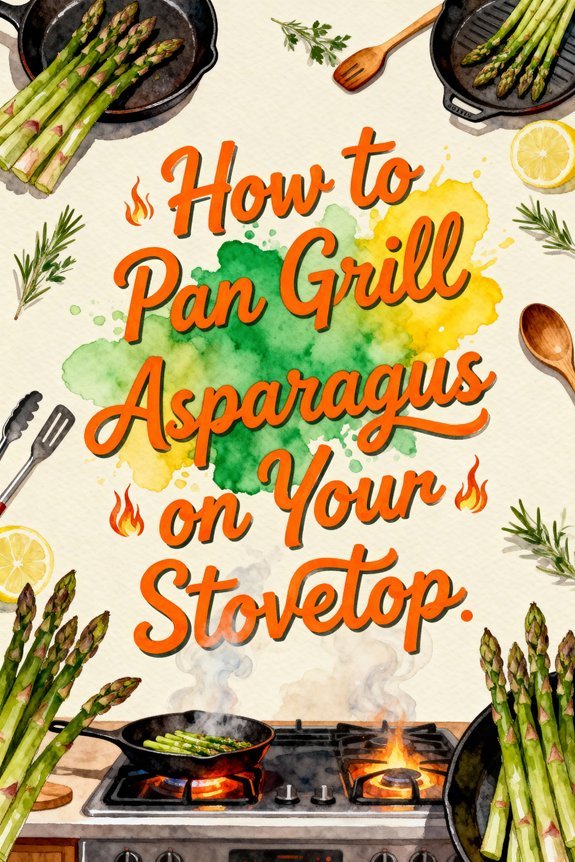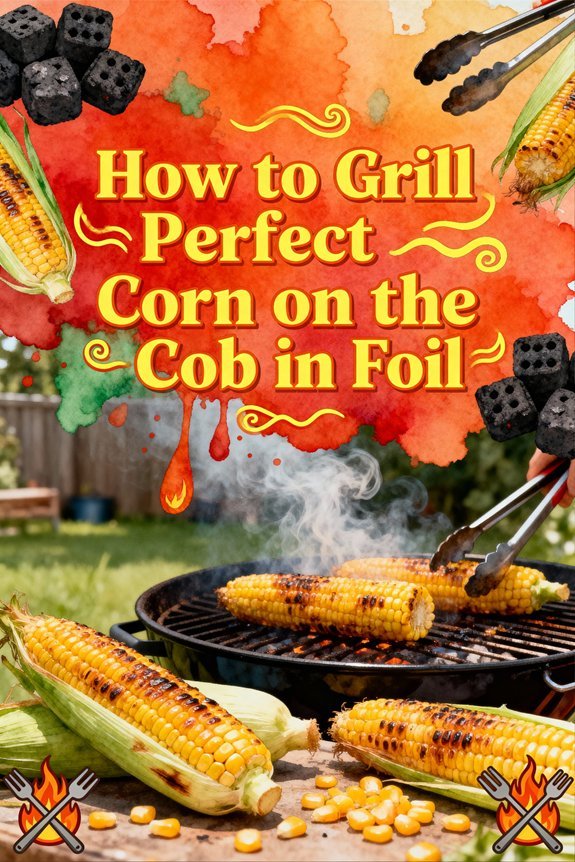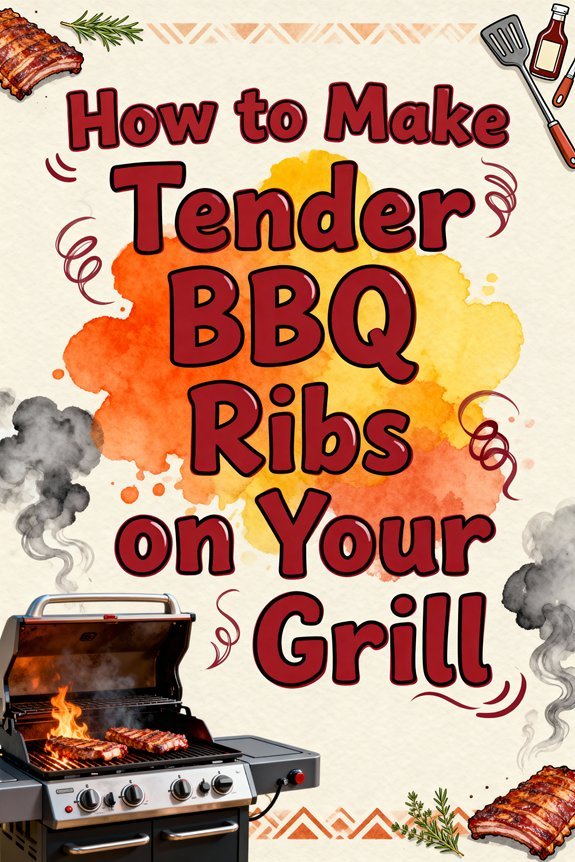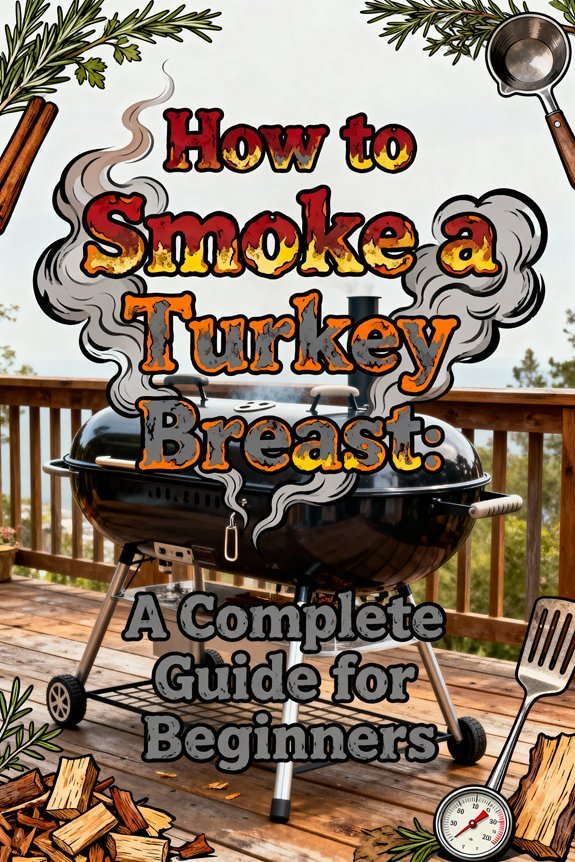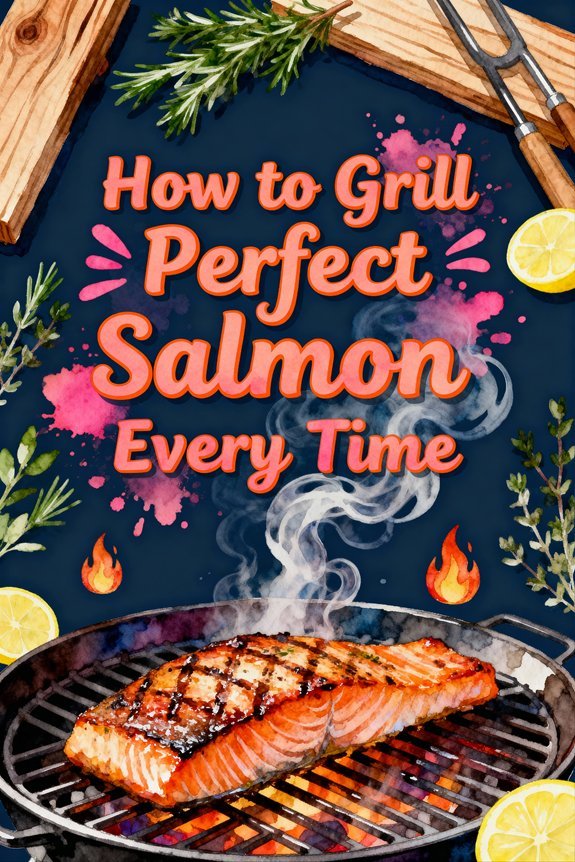To pan grill asparagus, preheat a cast-iron skillet or grill pan over medium-high heat (500-600°F). Once hot, add high-smoke-point oil and arrange trimmed spears in a single layer. Turn every 2-3 minutes until charred and tender-crisp, about 5-10 minutes total. Season with olive oil, kosher salt, and black pepper. For enhanced flavor, finish with garlic powder, fresh herbs, or citrus zest. Master these fundamentals to reveal countless variations and techniques.
Essential Tools and Kitchen Setup
Three essential tools form the foundation for successfully pan-grilling asparagus: a high-quality grill pan or cast iron skillet, sturdy tongs for precise handling, and a reliable spatula for flipping. Your kitchen organization should prioritize easy access to these essential equipment pieces, along with a designated cutting board for prep work.
Before cooking, make certain your stovetop range is clean and properly ventilated. Position your grill pan on a medium-high heat setting and allow it to preheat thoroughly – this step is vital for achieving proper sear marks. For optimal heat distribution and cooking results, consider using an induction cooktop. Clean the grates thoroughly after each use to prevent food residue buildup and ensure consistent cooking performance. Maintain adequate clearance around your cooking area to prevent accidents and enable efficient movement. The raised grates of your grill pan will facilitate proper caramelization while preventing unwanted steaming, delivering professional-quality results right from your home kitchen. Similar to foil packet grilling, this method helps seal in flavors and ensures even cooking throughout.
[affiai keyword=”cast iron grill pan with tongs” template=”carousel” count=”3″
Selecting and Preparing Fresh Asparagus
When selecting asparagus for pan grilling, prioritize spears that exhibit firm, straight stalks with tightly closed, compact tips – hallmark indicators of peak freshness. Look for rich green coloration that fades to white at the base, with tips that may display dark green or purple hues. Avoid dull-colored or limp stalks, as these signal compromised freshness. Using medium-high heat creates optimal charring and tenderness when cooking asparagus. Consider purchasing your asparagus during seasonal sales when grilling equipment and ingredients are often discounted.
Select medium to thick stalks for ideal pan grilling, as their higher water content withstands intense heat better than thin spears. Verify uniform thickness within your bundle to achieve consistent cooking results. Before preparation, trim the fibrous white bases to prevent woodiness. Store your asparagus upright in water or wrapped in damp paper towels in the refrigerator until you’re ready to cook, as cold storage helps prevent sugar-to-lignin conversion that leads to stringiness.
Step-by-Step Pan Grilling Method
Mastering the pan-grilling technique begins with proper equipment selection and heat management. Choose a cast-iron skillet or heavy-bottomed grill pan, and preheat it over medium-high heat. Similar to grilling steaks, you’ll want to achieve high heat temps of 500-600°F for optimal results. Once hot, add a tablespoon of high-smoke-point oil.
Arrange your chosen asparagus varieties in a single layer, ensuring they don’t overcrowd the pan. Different grilling techniques apply based on stalk thickness – thicker spears may require 8-10 minutes total cooking time, while thin ones need only 5-6 minutes. Turn the spears every 2-3 minutes using tongs. Just as with burger grilling, letting them rest for 5 minutes after cooking helps retain moisture. Always check that your spears are medium-thick to thick to avoid burning on the stovetop.
Monitor doneness by checking for bright green color and slight char marks. The asparagus should bend without snapping when tested. Transfer immediately to a warm serving plate and finish with your preferred seasonings or aromatics.
Perfect Seasoning and Flavor Combinations
To elevate pan-grilled asparagus from good to exceptional, proper seasoning techniques and complementary flavor pairings play a crucial role. Begin with a light coating of olive oil, then apply kosher salt and freshly ground black pepper as your foundational seasonings. For enhanced depth, incorporate garlic powder before grilling. Listen for sizzling while cooking to ensure optimal temperature control. Consider herb variations to match your culinary vision: thyme offers subtle earthiness, while rosemary provides robust pine notes. Add fresh herbs only after grilling to prevent burning. Just like maintaining clean grill grates helps preserve optimal cooking performance, proper seasoning enhances the natural flavors of asparagus. For best results, heat your pan to 400 degrees Fahrenheit, which is the ideal temperature for optimal cooking and cleaning. Finish with bright citrus zest or a squeeze of lemon juice to balance the char. For umami enhancement, sprinkle freshly grated Parmesan or drizzle with balsamic glaze. When seeking textural contrast, finish with large flaky salt crystals or experiment with infused oils for nuanced flavor profiles.
Expert Tips for Best Results
With proper seasoning established, success in pan grilling asparagus hinges on precise technical execution. Your grilling techniques should begin with preheating a heavy-gauge pan for 5 minutes at medium-high to achieve ideal cooking temperatures around 500°F. Start with a 12-ounce bundle of standard asparagus spears for best results. Arrange trimmed spears in a single layer, ensuring they’re uniformly sized for consistent results.
Monitor heat distribution carefully while turning spears every few minutes with tongs. You’ll recognize doneness when the asparagus develops a darker green hue and slight char marks, typically within 6-10 minutes depending on thickness. Just like with perfectly smoked meats, let the asparagus rest briefly after cooking to redistribute internal moisture. Don’t rely solely on timing; instead, assess tactile firmness and visual indicators. Remember to maintain high, dry heat throughout cooking – avoiding coverage that could trap steam and compromise texture. Keep your movements deliberate and efficient for restaurant-quality results. Similar to a wood pellet grill, this high-heat method creates excellent char while maintaining even heat distribution for consistent cooking.
[affiai keyword=”heavy gauge grill pan for asparagus” template=”carousel” count=”3″
Serving and Storage Recommendations
Once your asparagus achieves the perfect char and tenderness, proper serving and storage techniques become essential for maintaining its quality. For ideal serving suggestions, arrange the spears in a single layer and garnish with toasted nuts, citrus wedges, or shaved Parmesan. Consider pairing with proteins or offering complementary dipping sauces like aioli. Adding a poached egg transforms this versatile dish into a satisfying main course.
For storage tips, promptly refrigerate any leftover asparagus in an airtight container, where it’ll maintain freshness for up to three days. Similar to smoked meats, proper storage requires consistent refrigeration temperatures and minimal exposure to heat or sunlight. When reheating, use a preheated skillet with minimal oil, stirring occasionally to guarantee even warming. Avoid freezing, as it compromises texture. Monitor for food safety by discarding any spears showing signs of spoilage, and keep cooked asparagus out of the temperature danger zone (40-140°F) to prevent bacterial growth. For longer preservation of other grilled vegetables, consider proper freezing methods within the same day of cooking to maintain optimal quality.
[affiai keyword=”airtight food storage containers for vegetables” template=”carousel” count=”3″

